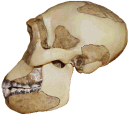A B C D E F G H I J K L M N O P Q R S T U V W X Y Z
Select the first letter of the word you are seeking from the list above
to jump to the appropriate section of the glossary or scroll down to it
- A -
-
Acheulian
 tool
tradition
tool
tradition - the most well known stone tool making tradition of Homo erectus and early archaic humans. It first appeared about 1.5 million years ago in East Africa and eventually spread throughout Africa, Southern Asia, and Southern Europe. The most diagnostic Acheulian artifact is the hand ax.
- adaptive radiation
- the relatively rapid expansion and diversification of an evolving group of organisms as they adapt to new ecological niches. Adaptive radiation is the process by which one species evolves into two or more species. This occurs as a result of different populations becoming reproductively isolated from each other, usually by adapting to different environments.
- archaic humans
- the variety
or species of humans that was intermediate between Homo
erectus and modern humans. The earliest archaic
humans
may have appeared shortly
after 800,000 years ago in Southern Europe and
East Africa. Elsewhere in the Old World, the
transition to archaic humans began around 400,000
years ago or later.
The most well known
late
archaic humans were the
Neandertals.
Archaic humans are also known as archaic
Homo sapiens
 and premodern humans. See
Homo
heidelbergensis.
and premodern humans. See
Homo
heidelbergensis. -
arthritis

- a degenerative disease characterized by chronic inflammation of the joints and accompanying pain.
- artifact

- a thing that has been manufactured or intentionally modified for some use. Stone tools such as hand axes are examples of artifacts.
- australopithecines

members of any species of the genus Australopithecus. They lived during the Pliocene and early Pleistocene geological Epochs in Africa (i.e., ca. 4.2-1.4 million years ago). Australopithecines and humans are hominins. One or more species of australopithecines probably were our ancestors.
awls
![]()
- small pointed tools for making holes in leather, wood, or other relatively soft materials. Awls are also referred to as borers.
- B -
- biface
- big game hunting
- a specialized subsistence pattern based primarily on hunting large animals, especially herbivorous herding mammals such as horses, reindeer, bison, and elephants.
- blade
flake

-
a
thin, roughly parallel-sided stone flake that is at least twice as long as it is
wide. They were made out of brittle breaking materials such as flint
 ,
chert
,
chert
 ,
and obsidian
,
and obsidian
 .
Blade flakes were preforms for the manufacture of many different kinds of
tools during the Upper Paleolithic--e.g.,
knives, hide scrapers, spear tips, drills, awls, and
burins. See punch
flaking.
.
Blade flakes were preforms for the manufacture of many different kinds of
tools during the Upper Paleolithic--e.g.,
knives, hide scrapers, spear tips, drills, awls, and
burins. See punch
flaking. - borer

-
see awl.
- Broca's
area

- a small area
of the human brain that controls the production of speech. It is
located in the left frontal lobe of the cerebral cortex
 .
See
Wernicke's
area.
.
See
Wernicke's
area. - bull roarer
- a musical instrument or noise maker consisting of a flat, elongated oval slab of rock, bone, or wood with a hole in one end through which a string is attached. When it is twisted and then whirled rapidly by the string, a humming or "roaring" noise is produced. Bull roarers may be only a few inches in length or several feet long.
-
 burins
burins

- narrow gouging chisels used to make and shape a host of other implements out of bone, tusks, antler, or wood. They were usually made from blade flakes in the late Upper Paleolithic tool traditions.
 |
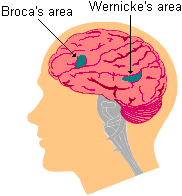 |
- C -
-
cerebrum

- the two large lobes at the top of the brain that make up about 85% of its weight in modern humans. Our high level mental functions, such as speech and processing complex information, occur in the cerebrum. The cerebral cortex, or outer surface, is deeply convoluted. About 2/3 of the human brain surface lies within these folds. The amount of cerebral cortex folding, and subsequently the surface area of the brain, increased as humans evolved from Homo habilis to Homo erectus and ultimately Homo sapiens.
- core
tool

- a tool made from a relatively large block of rock rather than from the flakes that are removed from it by percussion flaking in the manufacturing process. Most hand axes are core tools.
- cranial capacity
- Cro-Magnon

- the modern Homo sapiens who appeared in Europe by 40,000 years ago. Their skeletons generally were lighter than the Neandertals who occupied Europe at that time. The Cro-Magnon had broad, small faces with pointed chins and high foreheads. They are the ancestors of modern Europeans.
- D -
-
demography

- the study of population characteristics, especially its size, density, and growth patterns.
- E -
- ecological
niches

- specific micro-habitats in nature to which populations or organisms adapt. They are usually seen in terms of being food getting opportunities in the environment.
- F -
-
fetal
position

- laying partly curled on one's side with the legs and arms bent and held into the body.
-
flake
tool

- an artifact made from a flake knocked off of a larger rock usually by percussion flaking. Flakes may be intentionally produced for these purposes or they may be waste flakes produced in the process of making a core tool.
- G -
- gene flow
- the transference of genes from one population to another, usually as a result of migration. The loss or addition of individuals can easily change the gene pool frequencies of both the recipient and donor populations--that is, they can evolve.
- genetic drift
- evolution, or change in gene pool frequencies, resulting from random chance. Genetic drift occurs most rapidly in small populations. In large populations, random deviations in allele frequencies in one direction are more likely to be cancelled out by random changes in the opposite direction.
-
genome

- the full genetic complement of an individual (or a species). In humans, it is estimated that each individual possesses approximately 3 billion nucleotides in all of the DNA that makes up his or her genome.
- H -
- hand ax
- a rock core or large flake that has been systematically worked by percussion flaking to an elongated oval biface shape with one pointed end and sharp edges on the sides. In profile, hand axes usually have a teardrop or leaf shape. Hand axes are diagnostic tools of the Acheulian tool tradition of Homo erectus after about 1.5 million years ago. They continued to be made and used by Homo heidelbergensis, late archaic humans, and early modern Homo sapiens. Very likely, they were multipurpose implements used for light chopping of wood, digging up roots and bulbs, butchering animals, and cracking bones.
-
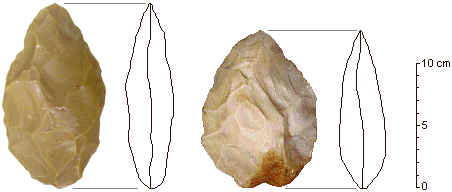
- hematite

- a rust red iron ore that was ground to a powder state and used as a paint pigment, beginning with the Neandertals and early modern humans.
-
hominid

- any species of the primate family Hominidae. The gorillas, chimpanzees, bonobos, australopithecines, and humans are hominids.
any species of the primate tribe Hominini. The australopithecines and humans are hominins
see hominin.
-
Homo
erectus

- the species of humans that followed Homo habilis and preceded Homo sapiens in our line of evolution. Homo erectus evolved in East Africa nearly 2 million years ago. They were the first humans to expand their range into Asia and Europe. By 800,000-400,000 years ago they were beginning a transitional evolutionary phase that would eventually lead to archaic humans and modern humans. See Homo heidelbergensis.
-
Homo
habilis

- a transitional species between the australopithecines and Homo erectus. Homo habilis may have first appeared by 2.4 million years ago and continued until about 1.6 million years ago. They lived in East and possibly South Africa.
-
Homo
heidelbergensis

- A very early form of archaic humans in Europe and North Africa that lived from about 800,000 to 200,000 years ago. In an alternate interpretation, some researchers consider Homo heidelbergensis to be a separate species or even a late advanced Homo erectus in transition to archaic humans. Homo heidelbergensis may have been the ancestor of the Neandertals.
-
Homo
neanderthalensis

- the species designation given to the Neandertals by researchers who believe that these ancient people were different enough from Homo sapiens to assign them to a distinct species.
-
Homo
sapiens

- Our species of humans. Homo sapiens evolved from Homo erectus over several hundred thousand years beginning at least 400,000 years ago. The first modern Homo sapiens began evolving from archaic humans in East Africa shortly after 200,000 years ago. Modern humans are referred to as Homo sapiens sapiens. The last sapiens refers to our sub-species or variety designation.
-
Homo
sapiens neanderthalensis

- the species designation given to the Neandertals by researchers who believe that these ancient people were genetically close enough to Homo sapiens to assign them to the same species but a different sub-species or variety. See Homo neanderthalensis.
-
Homo
sapiens sapiens

- See Homo sapiens.
-
hyoid bone

- a horseshoe-shaped bone in the neck above the larynx supporting the base of the tongue. Since jaw, tongue, and larnyx muscles are anchored to it, the hyoid bone is essential for the production of sounds used in human speech. Humans are the only primates that have their hyoid bones high in the neck. Subsequently, they can produce a wider range of vocal sounds than other primates.
 |
|
|
|
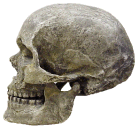 |
 |
- I -
- imitative magic
- See sympathetic magic.
- J -
- K -
- L -
- Levallois
 flake
flake - flakes of more or less standardized shapes and sizes made with a specific technique in the late Acheulean tool tradition of Homo heidelbergensis and was refined in the Mousterian tool tradition of the Neandertals and some of their contemporaries. Flint and other brittle fracturing rock cores were percussion flaked on one side until a convex "tortoise shell" shape was formed. Then, a heavy percussion blow at one end of the core removed a large flake that was convex on one side and relatively flat on the other. This was a Levallois flake.
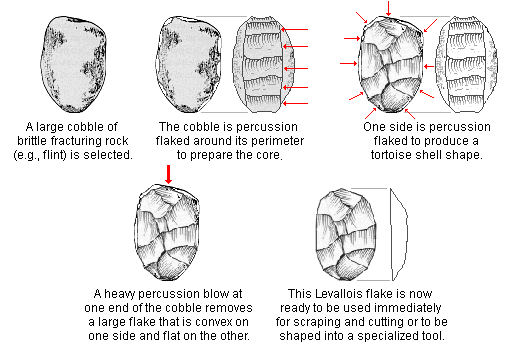
- Lower Paleolithic
- the earliest and
longest part of the Paleolithic
 stage of development. The Lower
Paleolithic began with the Oldowan Tool
Tradition of Homo habilis and
continued with the Acheulian Tradition
of Homo erectus and early
archaic
humans. The Lower Paleolithic began about 2.5-2.4 million
years ago and continued until after 100,000 years ago. Lower Paleolithic tool making was the height of technology for most of the time
that we have been human.
stage of development. The Lower
Paleolithic began with the Oldowan Tool
Tradition of Homo habilis and
continued with the Acheulian Tradition
of Homo erectus and early
archaic
humans. The Lower Paleolithic began about 2.5-2.4 million
years ago and continued until after 100,000 years ago. Lower Paleolithic tool making was the height of technology for most of the time
that we have been human.
- M -
-
midden

- an archaeological term referring to composted soil resulting from a refuse heap left by humans in the past. Middens often contain artifacts and food refuse remains such as bone and mollusk shell fragments.
- Middle Paleolithic
- the part of the Paleolithic
 stage of development in which the Mousterian
tool tradition
of the Neandertals and early modern humans was
used. The Middle Paleolithic began
sometime between 250,000 and 100,000 years ago and continued until at least 28,000 years ago.
stage of development in which the Mousterian
tool tradition
of the Neandertals and early modern humans was
used. The Middle Paleolithic began
sometime between 250,000 and 100,000 years ago and continued until at least 28,000 years ago. - mitochondria
 (singular mitochondrion
(singular mitochondrion
 )
) - small rod-like structures in the cytoplasm of a cell that produce fuel for the cell in the form of adenosine triphosphate (ATP). A small amount of DNA is located in mitochondria. A small amount of DNA in a circular looping chromosome is located in mitochondria. This DNA is normally inherited only from mothers and is distinct from DNA that makes up the chromosomes within the cell nucleus.
- mitochondrial
DNA
 (mtDNA)
(mtDNA) - DNA located in the mitochondria. Since it is inherited only from mothers, an offspring's mtDNA will be identical to its mother's, unless a mutation has occurred.
- mosaic pattern of evolution
- a pattern of evolution in which different parts of the body evolve at different rates. In the case of humans, we essentially attained our modern form below the neck by at least 2 million years ago. However, our cranial capacity did not reach its current size until after 100,000 years ago.
-
Mousterian
 tool tradition
tool tradition - the most advanced tool making tradition of the Neandertals. It was also shared by some other late archaic humans and early modern Homo sapiens. The Mousterian tradition, which began around 75,000 years ago was characterized by a progressive decrease in emphasis on core tools and a corresponding increase in the importance of flake tools--especially those made with the Levallois technique. The Mousterian tradition was sufficiently advanced over the earlier Acheulian Tradition from which it was derived to be placed into the Middle Paleolithic.
- N -
- natural selection
- an evolutionary mechanism that occurs when some individuals of a population are better able to adapt to their environment and, subsequently, produce more offspring. Nature, in effect, selects which members of a population are fit to survive long enough to reproduce. Differential productive success between individuals is the key. Those who produce more offspring have a greater influence on the gene frequencies of the next generation. This mechanism of evolutionary change was first articulated by Charles Darwin.
- Neandertals

- the most well known late archaic humans. They lived mostly in Europe and the Southwest Asia from at least 130,000 years ago until at sometime around 28,000 years ago. Early evidence of Neandertal-like characteristics are seen in the fossil record of Spain beginning about 400,000 years ago. There is an on-going debate as to whether they should be considered Homo sapiens or a distinct but related species. If they were members of our species, they were a different variety or race (Homo sapiens neanderthalensis). On the other hand, if they were different enough to be a distinct species, they should be considered to be Homo neanderthalensis.
-
nucleotide

- the basic building block of DNA molecules. It consists of any one of four specific purine or pyrimidine bases attached to a ribose or deoxyribose sugar and phosphate group.
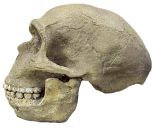 |
- O -
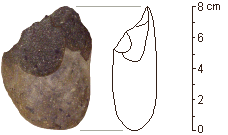 |
- Oldowan
 tool
tradition
tool
tradition - the earliest stone tool making tradition. The first Oldowan artifacts were made in East Africa about 2.5-2.4 million years ago presumably by Homo habilis and continued to be made by early Homo erectus until about 1.5 million years ago. They consisted of simple core (shown here) and flake tools only slightly modified from their natural state by percussion flaking.
- Old Stone Age
- see Paleolithic.
- P -
-
Paleolithic

- the earliest stone tool making traditions from the first ones made by Homo habilis down to the most advanced ones of the last Ice Age made by modern Homo sapiens. Paleolithic literally means "Old Stone" Age. See Lower, Middle, and Upper Paleolithic.
- percussion
flaking

- a tool making technique in which a brittle rock (e.g., obsidian, flint, chert, and basalt) that will potentially be an artifact is struck with a heavy glancing blow from another dense rock (i.e., a hammerstone) in order to cause a flake to be removed. An artifact can be shaped by carefully and systematically directing the percussion blows with the hammerstone. Percussion flaking works when a sufficiently large shock wave is directed into the target rock so that the elastic limit of the material is exceeded. This causes one or more flakes to be broken off. See pressure flaking.
- prepared core
- a rock core that has been preliminarily shaped by rough percussion flaking in order to remove flakes of standardized sizes and shapes. See punch flaking and Levallois flake.
- pressure
flaking

- a tool making
technique developed in the Upper Paleolithic
as a further refinement in shaping brittle-flaking rock (e.g., obsidian
 ,
flint
,
flint
 ,
chert
,
chert
 ,
and basalt
,
and basalt
 )
artifacts . After preliminary shaping by percussion
flaking, they often finished a tool with pressure flaking.
They used a hard pointed object, like the tip of a deer antler, to literally
push off flakes in the final shaping and thinning process. This
resulted in small, regular flake scars and much greater control in
determining the shape of the final product. Pressure flaking was also
used to retouch, or sharpen, sharp edges.
)
artifacts . After preliminary shaping by percussion
flaking, they often finished a tool with pressure flaking.
They used a hard pointed object, like the tip of a deer antler, to literally
push off flakes in the final shaping and thinning process. This
resulted in small, regular flake scars and much greater control in
determining the shape of the final product. Pressure flaking was also
used to retouch, or sharpen, sharp edges. - punch
flaking

- An Upper Paleolithic technique for making blade flakes. After first preparing a rock core, a hard pointed punch (usually made from a deer antler tip) is placed near the edge of a striking platform and a percussion blow with a hammer to the top of the punch sends a controlled shock wave into the core which removes a thin, narrow blade flake. Upper Paleolithic cores prepared for this technique were usually conical or cylindrical in shape with a relatively flat perpendicular striking platform at one end.
- punctuated evolution
- an evolutionary history in which a species remains essentially unchanged for hundreds of thousands or even millions of years and then experiences short periods of very rapid evolution. The punctuated, or rapid change periods, are the result of major environmental changes in predation pressure, food supply, climate, etc. During these times, natural selection may favor varieties that were previously at a comparative disadvantage. The result is an accelerated rate of change in gene pool frequencies in the direction of the varieties that became the most favored by the new environmental conditions.
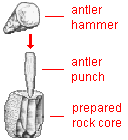 |
- Q -
- R -
- random sample
- a sample that is selected by a researcher without any bias whatsoever. In other words, all samples in a population have an equal probability of being selected. This can be achieved by using a computer to randomly select the sample.
- Rickets
disease

- a disease of the skeletal system in which the bones are softened and often bent as a result of vitamin D deficiency in the diet that hinders the normal development of bones and teeth. Rickets most frequently affects malnourished children.
- ritual

- a stylized and usually repetitive act that takes place at a set time and location. Rituals are integral parts of religion, though not all rituals are religious in nature.
- S -
- shovel-shaped incisors
- incisor teeth that have a "scooped out" appearance on the tongue side. This pattern is characteristics of East Asian and Native American Populations today. It was also common among Homo erectus.
- subsistence pattern
- referring to sources of food and the way they are obtained (e.g., scavenging, hunting, and farming). Subsistence base is another name for subsistence pattern. "Subsistence strategy" refers to decisions made by people as to the best way to obtain food in a particular environment (e.g., diversified foraging, specialized big game hunting, etc.).
- subarctic
- referring to climatic regions that are next to the arctic circle (e.g., Northern Alaska and Northern Canada) and that have extremely long cold winters with a great deal of snow and little or no day light. Subarctic regions are farther north than temperate ones in the northern hemisphere.
- subtropical
- sympathetic magic
- a magical practice based on the principle that like causes like. For those who believe that this works, it would be possible to cause another person or animal harm by making an image of them and doing something to harm the image such as painting a spear sticking into the body. The animal of whom the image is a likeness would supposedly suffer the same effects. The Cro-Magnon cave paintings of animals being wounded or pregnant was very likely attempts to use sympathetic magic to cause the same effects on the real animals. Sympathetic magic is also called imitative magic.
- T -
- temperate
- referring to climatic regions between subtropical and subarctic zones. Temperate areas usually have winter snow and are too cold to grow oranges and avocados. However, summer temperatures can be warm.
- thong
stropper

- a tool for shaping and softening leather thongs by repeatedly pulling them under tension through a hole.
-
toggle-head
harpoon

- a bone or antler harpoon tip or point with a hole for attaching a rope. It is designed so that when the harpoon is thrust into the body of a large animal, the wooden shaft falls off. The hunter keep holds of the animal with the rope attached to the toggle-head harpoon point stuck in its body.
- tropical
- referring to the usually warmest climatic regions. They are mostly found within 20-30 latitude from the Equator. All human evolution until relatively late Homo erectus occurred in the tropics, especially in Africa. See subtropical and temperate.
- U -
a stone tool that is shaped only on one face or side. See biface.
- Upper Paleolithic
- the last part of the
Paleolithic
 stage of development
in which Cro-Magnon and other late ice age modern Homo
sapiens developed a number of sophisticated stone tool making
traditions including the Magdalenian. This was the height of technical
sophistication during the Old Stone Age. The Upper Paleolithic in
Europe began about 40,000 years ago and ended around 10,000 years
ago. Technological developments leading to the
Upper Paleolithic may have begun by at least 75,000 years ago in Africa.
stage of development
in which Cro-Magnon and other late ice age modern Homo
sapiens developed a number of sophisticated stone tool making
traditions including the Magdalenian. This was the height of technical
sophistication during the Old Stone Age. The Upper Paleolithic in
Europe began about 40,000 years ago and ended around 10,000 years
ago. Technological developments leading to the
Upper Paleolithic may have begun by at least 75,000 years ago in Africa.
- V -
 |
- Venus
figurines

- small carvings of women that could fit into the hand made by the Cro-Magnon people. They were not portraits but rather faceless idealized representations of well fed, healthy, usually pregnant women with large buttocks. Because of these characteristics, they are thought by most paleoanthropologists to be ritual objects symbolizing female fertility. Many of these stylized carvings are reminiscent of modern abstract art. Venus figurines were made from 27,000 years ago down to the end of the last ice age 10,000 years ago.
- W -
- Wernicke's
area

- a small area
of the human brain that is involved in the comprehension of speech. It
is located in the cerebral cortex
 .
See Broca's area for
illustration.
.
See Broca's area for
illustration.
- X -
- Y -
- Z -
Copyright 2000-2014 by
Dennis
O'Neil.
All rights reserved.
illustration
credits

